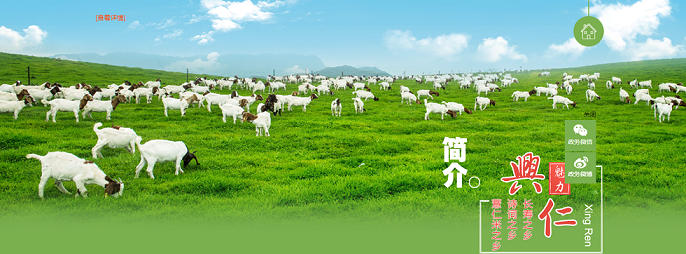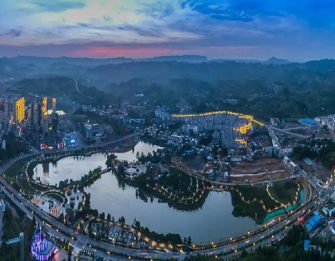- Profile Jurisdictions GOV DEPARTMENTS Cultures Travelling Educate
-
Xingren City is located in the southwest of Guizhou Province and the central part of Qianxinan Buyei and Miao Autonomous Prefecture, at the junction of Yunnan, Guizhou, and Guangxi provinces (autonomous regions). It boasts a superior geographical location and convenient transportation. The city covers a total area of 1,778.3 square kilometers and administers 12 townships and 6 subdistricts. It is home to 16 ethnic groups including Han, Buyi, and Miao. As of the end of 2024, the total population reached 576,600 (including Yuzhang), with 160,500 ethnic minority residents accounting for 27.8% of the total population. In recent years, Xingren has earned honors such as “China's Coix Seed Capital,” “China's Longevity Capital,” “National Advanced County for Grain Production,” “National Advanced County for Scientific and Technological Progress,” National Advanced County for Cultural Development,“ and ”China's Hometown of Authentic Traditional Chinese Medicinal Materials." In 2018, it achieved poverty alleviation and was the first county in Qianxinan Prefecture to be removed from the poverty list.

The city boasts a rich historical and cultural heritage. During the Spring and Autumn Period, the area belonged to the Kingdom of Zangke. In the Warring States Period, as well as under the Qin and Han dynasties, it was part of the Kingdom of Yelang. After the fall of Yelang, the Han Dynasty established Loujiang County within the present-day city boundaries. In the 16th year of the Hongwu reign of the Ming Dynasty (1383), a new city was constructed. During the 19th year of the Qianlong reign of the Qing Dynasty (1754), a patrol inspector was stationed in the present-day city center, which was named Xincheng Town. In the 3rd year of the Jiaqing reign (1798), Xincheng County was established with a deputy magistrate appointed. In the 3rd year of the Xuantong reign (1911), the Xincheng Autonomous Office was established. In the first year of the Republic of China (1912), the position of Xincheng County Magistrate was reinstated. In the third year of the Republic (1914), the Beiyang government renamed it Xingren County, inspired by the phrase “When one family practices benevolence, benevolence flourishes throughout the nation” from the Book of Rites: The Great Learning. In the early years of the People's Republic of China, Xingren served as the seat of the Xingyi Prefectural Administrative Office. On September 28, 2018, it completed its historical mission of county-to-city conversion and was officially renamed “Xingren City.”

The ecological environment is pleasant. Xingren City lies within the low-latitude plateau subtropical humid monsoon climate zone, characterized by an average annual precipitation of 1300–1450 mm, an average elevation of 1253 meters, and an annual average temperature of 15.2°C. Temperatures below 0°C occur for no more than 4 days, while temperatures above 30°C occur for no more than 20 days. The frost-free period lasts 281 days. Winters are mild without severe cold, summers are cool without extreme heat, rainfall is abundant, the ecosystem is healthy, the air is fresh, and the climate is pleasant. The city boasts a forest coverage rate of 55.1% and 100% excellent air quality, making it a national pilot base for forest health and wellness development and one of the world's most livable places.
Transportation is highly accessible. With a prominent geographical advantage, the city has established an integrated transportation network encompassing highways, railways, waterways, and aviation. Key transportation hubs—including Xingyi Station on the Nanchong-Kunming Railway, Xingyi Wanfenglin Airport, the Shanghai-Kunming High-Speed Railway, and Zhenfeng Baiceng Port—are all within approximately 50 kilometers. The Qingxing and Huixing expressways traverse the city, connecting to the Shantou-Kunming and Shanghai-Kunming expressways. The planned Guiyang-Xingyi Railway will traverse the entire region, establishing Xingren as a vital transportation hub for Southwest Guizhou. It serves as a key junction connecting northward to Sichuan and Chongqing, southward to Guangdong and Guangxi, and westward to Yunnan and Myanmar, while also functioning as a bridgehead for accessing Southeast Asia. Xingren is a major distribution center for goods in the Upper Xijiang River Economic Zone.

The city boasts abundant mineral resources. Xingren possesses 21 types of minerals including coal, gold, quartz sand, and fluorite. Key figures include: proven coal reserves of 3.6 billion tons with prospective reserves exceeding 4.5 billion tons. Twenty-eight coal mines within the city have obtained qualifications for merger and restructuring, comprising one open-pit mine and one combined underground-open-pit operation. with an annual production capacity of 15.3 million tons. This output accounts for over 40% of the prefecture's total coal production, ranking first in the prefecture for eight consecutive years. Prospective gold reserves exceed 100 tons, with proven (filed) reserves totaling 68.13 tons of metal. Xingren produced Guizhou Province's first gold nugget in late 1986 and surpassed the milestone of 10,000 taels of gold production in the early 1990s. Currently, our city is accelerating the development of the gold industry, with an annual ore production target of 32,000 tons by 2024. In recent years, Xingren City has leveraged its coal resources and local power grid as a foundation to vigorously advance the aluminum and aluminum processing industries. This strategy extends the coal industry chain, striving to build a sustainable “coal-power-aluminum+” circular economy model characterized by: coal-to-power generation, power-to-grid reinforcement, grid-to-aluminum promotion, aluminum-to-power integration, and power-to-coal enhancement. Key sectors include: - Light industry centered on chemical fibers, textiles, apparel, electronics, luggage, footwear, and high-tech products; - Mountainous high-efficiency agriculture focused on Job's tears, small yellow cattle, tea, and premium fruits; - Modern mountain tourism leveraging natural resources and mountain water systems. The city aims to achieve a comprehensive industrial layout characterized by “hundred-billion-yuan-level industries, fourth-generation manufacturing, export processing, and balanced light and heavy industries.”
In 2024, the city's GDP reached 20.183 billion yuan, marking a 3.2% year-on-year increase. Specifically: - Primary industry added value: 3.786 billion yuan, up 4.0% - Secondary industry added value: 7.279 billion yuan, up 6.1% - Tertiary industry added value: 9.118 billion yuan, up 0.9%
contact details
Tel:00-86-0859-6212066
Address:No.20, Democracy Road, Chengbei Street, Xingren City, Guizhou Province, China
Working hours:Monday to Friday (8:30-12:00 14:30-18:00)
